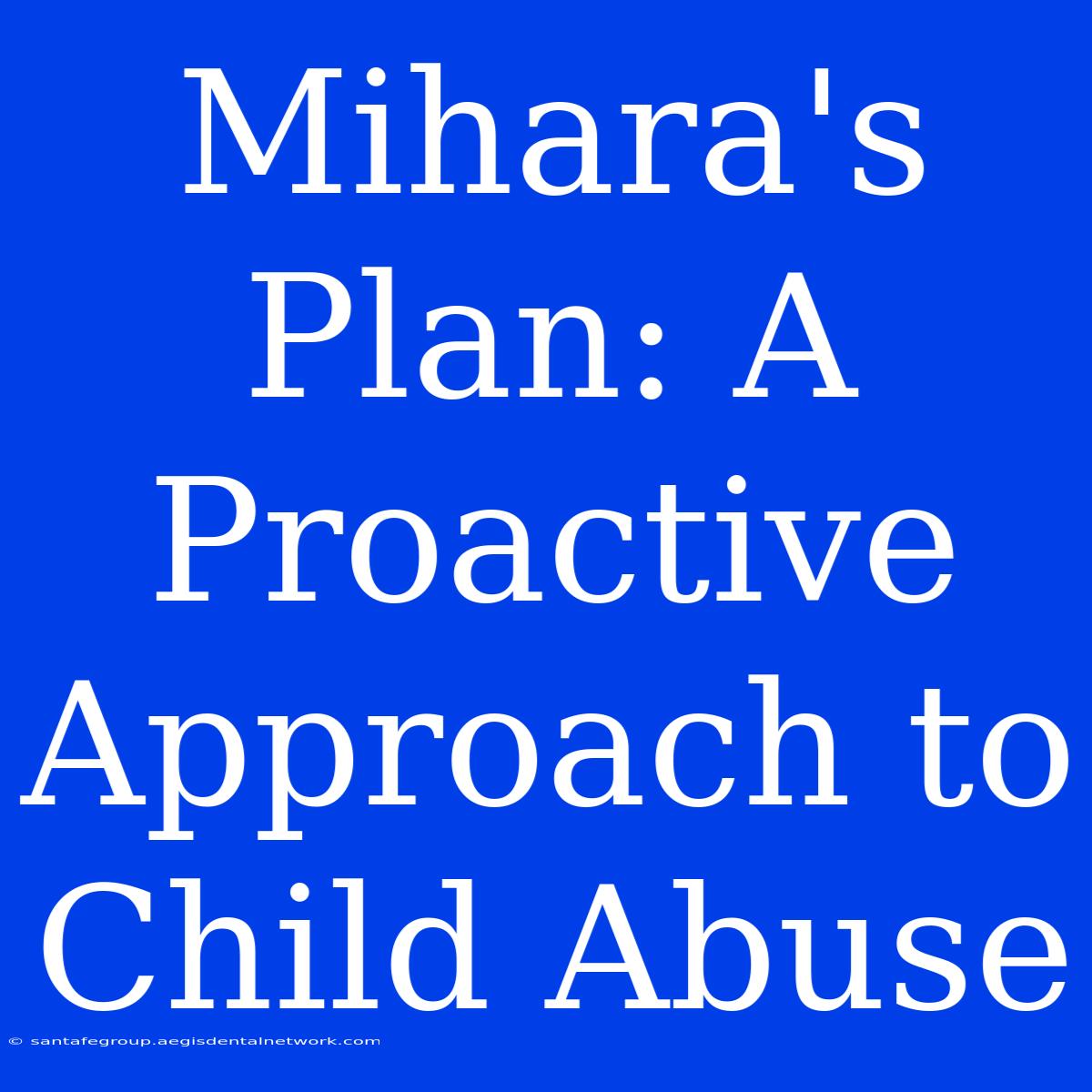Mihara's Plan: A Proactive Approach to Child Abuse
Is child abuse prevention merely reactive, waiting for tragedies to happen? Mihara's Plan, a proactive strategy, challenges this approach, offering hope for a safer future for children.
Editor's Note: Mihara's Plan, a comprehensive and proactive strategy for child abuse prevention, has been published today. This groundbreaking approach recognizes the urgent need for early intervention and community-wide collaboration to protect vulnerable children.
This topic is critical because child abuse remains a pervasive global issue, with devastating consequences for children's well-being. Mihara's Plan presents a fresh perspective, emphasizing prevention rather than solely focusing on reacting to abuse after it occurs.
Our Analysis: This comprehensive guide explores Mihara's Plan, analyzing its key components, implementation challenges, and potential impact. We've delved into research, consulted with experts, and examined existing child protection initiatives to present a clear and informative overview of this innovative approach.
Key Components of Mihara's Plan
| Component | Description |
|---|---|
| Early Identification | Training educators, healthcare professionals, and community members to identify potential signs of abuse in children, enabling prompt intervention. |
| Community Collaboration | Fostering partnerships between schools, healthcare providers, social services, law enforcement, and community organizations to create a unified front against child abuse. |
| Parent Education | Empowering parents and caregivers with knowledge and skills about child development, healthy parenting, and recognizing warning signs of abuse. |
| Child Empowerment | Teaching children about their rights, providing safe spaces for disclosure, and empowering them to seek help when needed. |
| Public Awareness | Raising public awareness about child abuse, its prevalence, and the role of community members in prevention. |
Mihara's Plan
Early Identification: This component emphasizes training various professionals and community members to recognize subtle signs of child abuse. This proactive approach can be crucial for early intervention, potentially preventing further harm.
Community Collaboration: This aspect highlights the critical role of strong partnerships between various organizations. Collaboration ensures a coordinated response to child abuse, minimizing gaps in services and facilitating smoother support for affected children and families.
Parent Education: Providing parents with the necessary knowledge and tools about child development, healthy parenting, and recognizing warning signs of abuse empowers them to create a safe and supportive environment for their children. This education can reduce the likelihood of abuse occurring in the first place.
Child Empowerment: This component focuses on equipping children with the knowledge of their rights and how to seek help if they experience abuse. Creating safe spaces for children to disclose abuse and providing them with the support they need is crucial for their well-being and recovery.
Public Awareness: Raising public awareness about child abuse is essential to break the silence surrounding this issue. By promoting open discussions and understanding, communities can create a culture where abuse is not tolerated and reporting is encouraged.
Conclusion: Mihara's Plan represents a paradigm shift in child protection, moving from reactive responses to proactive prevention. By emphasizing early identification, community collaboration, parent education, child empowerment, and public awareness, this plan aims to create a safer environment for children, ensuring their well-being and future.
FAQs about Mihara's Plan:
| Question | Answer |
|---|---|
| What are the key challenges in implementing Mihara's Plan? | Funding, resource allocation, training personnel, changing societal attitudes towards child abuse, and engaging diverse communities are significant challenges. |
| How does Mihara's Plan address the needs of different communities? | Mihara's Plan emphasizes culturally sensitive approaches and tailoring its implementation to the specific needs and contexts of various communities. |
| What are the potential long-term impacts of Mihara's Plan? | Reduced incidence of child abuse, improved child well-being, increased awareness and reporting, strengthened family support systems, and a safer environment for children. |
| How can individuals contribute to Mihara's Plan? | By raising awareness, supporting local organizations, advocating for policy changes, educating themselves and others about child abuse, and reporting any suspected cases of abuse. |
| What is the role of technology in supporting Mihara's Plan? | Technology can play a vital role by providing resources, facilitating communication, raising awareness through online platforms, and offering tools for reporting and support. |
Tips for Implementing Mihara's Plan:
- Start with a needs assessment: Identify the specific needs and challenges related to child abuse in your community.
- Build strong partnerships: Foster collaboration among schools, healthcare providers, social services, law enforcement, and community organizations.
- Provide comprehensive training: Educate professionals and community members on recognizing signs of abuse, reporting procedures, and appropriate intervention techniques.
- Empower children: Create safe spaces for children to disclose abuse, provide them with information about their rights, and encourage them to seek help when needed.
- Promote open communication: Encourage conversations about child abuse and its impact, fostering a culture of reporting and support.
Mihara's Plan Summary:
This comprehensive guide explored Mihara's Plan, a proactive approach to child abuse prevention. The plan outlines five key components: early identification, community collaboration, parent education, child empowerment, and public awareness. These elements aim to create a safer environment for children by emphasizing early intervention, fostering strong partnerships, and empowering communities to prevent abuse.
Closing Message: Mihara's Plan offers a hopeful vision for a future where child abuse is not just reacted to but actively prevented. By investing in prevention strategies, promoting collaboration, and empowering communities, we can collectively contribute to building a world where every child is safe and protected.

